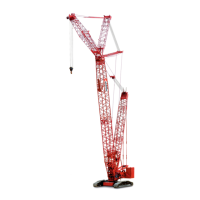National Crane Published 12-21-2012 Control # 103-06 3-9
1400A OPERATORS MANUAL OPERATING CONTROLS & PROCEDURES
• the RCL and anti-two-block system for proper operation.
• the electrical wiring connecting the various parts of the
system for physical damage.
NOTE: Consult the truck manufacturer’s manual for
vehicle checks.
Cold Weather Operation
The following recommendations are for operating National
cranes in very low (i.e., sub-zero) temperatures.
Cranes should have appropriate hydraulic oil, lubricants, and
other auxiliary items required for operation in sub-zero
temperatures. Operate individual crane functions to ensure
they are sufficiently warmed prior to performing a lift.
Operation of cranes at full rated capacities in temperatures
between -18°C (0°F) and -40°C (-40°F) or lower should be
accomplished only by competent operators who possess the
skill, experience, and dexterity to ensure smooth operation.
Shock loading shall be avoided.
Derated capacities for each °C below -40°C
Derate the rated load shown on the capacity charts 3.67
percent for each degree celsius below -40° C.
Derated capacities for each °F below -40°F
Derate the rated load shown on the capacity charts 2 percent
for each degree fahrenheit below -40° F.
Anti-two-block Check
Check the anti-two-block alarm light and the audible alarm
by lifting the anti-two-block weight until the switch is
activated. To check the anti-two-block switch:
• manually lift the weight.
• slowly raise the hoist cable.
• slowly extend (telescope) the boom.
If the crane is equipped with a jib that is deployed and rigged
for work, repeat the test procedure for the jib anti-two-block
switch.
RCL Check
Perform the following checks to verify proper RCL operation.
• Check that the display of the main boom length agrees
with the actual boom length.
• Check that the display of the main boom angle agrees
with the actual boom angles.
• Check that the display of the operating radius of the
crane agrees with the actual radius.
Check the load display by lifting a load of known weight. The
accuracy of the load indication shall be within the tolerance
of SAE J159.
HOIST SYSTEM OPERATION
The hoist may have lifting capabilities greater than that of the
crane limits. Therefore, care must be taken to ensure that the
load lifted is within the crane rating. General rules for hoist
operation are:
• Unwind the hoist when extending the boom.
• Use the anti-two-block system only as an aid.
• Make sure the rope is not twisted or kinked and that it is
properly seated in the hoist and in sheaves.
• Always have at least three full wraps of cable on the
hoist.
• Check the hoist brake when approaching the load limit of
the hoist. Raise the load a few inches and return the
control to neutral to check the brake.
• Do not drag the load with the hoist.
• Do not try to lift loads that are not free such as, frozen
down material or poles.
• Keep tension on the rope to prevent it from becoming
twisted, kinked, or improperly seated on the hoist.
Hoist Two Speed Operation
The high speed increases hoist line speed over normal
operation. The high speed mode is activated by a switch
located on the crane cab console.
DANGER
The following tests must be performed with caution to
prevent damage to the machine or injury to personnel.
DANGER
If the light and audible alarm do not function and the hoist
does not stop, the system is not working properly and
must be corrected before operating the crane.
DANGER
A deviation between displayed and actual values
indicates a malfunction and a RCL service representative
shall be called for repair and/or recalibration of RCL
system.
Reference Only

